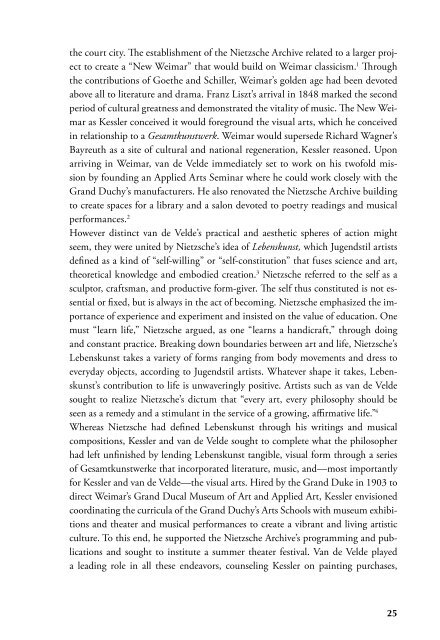The Death and Life of the Total Work of Art – Henry van de Velde and the Legacy of a Modern Concept
ISBN 978-3-86859-261-0
ISBN 978-3-86859-261-0
Create successful ePaper yourself
Turn your PDF publications into a flip-book with our unique Google optimized e-Paper software.
<strong>the</strong> court city. <strong>The</strong> establishment <strong>of</strong> <strong>the</strong> Nietzsche Archive related to a larger project<br />
to create a “New Weimar” that would build on Weimar classicism. 1 Through<br />
<strong>the</strong> contributions <strong>of</strong> Goe<strong>the</strong> <strong>and</strong> Schiller, Weimar’s gol<strong>de</strong>n age had been <strong>de</strong>voted<br />
above all to literature <strong>and</strong> drama. Franz Liszt’s arrival in 1848 marked <strong>the</strong> second<br />
period <strong>of</strong> cultural greatness <strong>and</strong> <strong>de</strong>monstrated <strong>the</strong> vitality <strong>of</strong> music. <strong>The</strong> New Weimar<br />
as Kessler conceived it would foreground <strong>the</strong> visual arts, which he conceived<br />
in relationship to a Gesamtkunstwerk. Weimar would superse<strong>de</strong> Richard Wagner’s<br />
Bayreuth as a site <strong>of</strong> cultural <strong>and</strong> national regeneration, Kessler reasoned. Upon<br />
arriving in Weimar, <strong>van</strong> <strong>de</strong> Vel<strong>de</strong> immediately set to work on his tw<strong>of</strong>old mission<br />
by founding an Applied <strong>Art</strong>s Seminar where he could work closely with <strong>the</strong><br />
Gr<strong>and</strong> Duchy’s manufacturers. He also renovated <strong>the</strong> Nietzsche Archive building<br />
to create spaces for a library <strong>and</strong> a salon <strong>de</strong>voted to poetry readings <strong>and</strong> musical<br />
performances. 2<br />
However distinct <strong>van</strong> <strong>de</strong> Vel<strong>de</strong>’s practical <strong>and</strong> aes<strong>the</strong>tic spheres <strong>of</strong> action might<br />
seem, <strong>the</strong>y were united by Nietzsche’s i<strong>de</strong>a <strong>of</strong> Lebenskunst, which Jugendstil artists<br />
<strong>de</strong>fined as a kind <strong>of</strong> “self-willing” or “self-constitution” that fuses science <strong>and</strong> art,<br />
<strong>the</strong>oretical knowledge <strong>and</strong> embodied creation. 3 Nietzsche referred to <strong>the</strong> self as a<br />
sculptor, craftsman, <strong>and</strong> productive form-giver. <strong>The</strong> self thus constituted is not essential<br />
or fixed, but is always in <strong>the</strong> act <strong>of</strong> becoming. Nietzsche emphasized <strong>the</strong> importance<br />
<strong>of</strong> experience <strong>and</strong> experiment <strong>and</strong> insisted on <strong>the</strong> value <strong>of</strong> education. One<br />
must “learn life,” Nietzsche argued, as one “learns a h<strong>and</strong>icraft,” through doing<br />
<strong>and</strong> constant practice. Breaking down boundaries between art <strong>and</strong> life, Nietzsche’s<br />
Lebenskunst takes a variety <strong>of</strong> forms ranging from body movements <strong>and</strong> dress to<br />
everyday objects, according to Jugendstil artists. Whatever shape it takes, Lebenskunst’s<br />
contribution to life is unwaveringly positive. <strong>Art</strong>ists such as <strong>van</strong> <strong>de</strong> Vel<strong>de</strong><br />
sought to realize Nietzsche’s dictum that “every art, every philosophy should be<br />
seen as a remedy <strong>and</strong> a stimulant in <strong>the</strong> service <strong>of</strong> a growing, affirmative life.” 4<br />
Whereas Nietzsche had <strong>de</strong>fined Lebenskunst through his writings <strong>and</strong> musical<br />
compositions, Kessler <strong>and</strong> <strong>van</strong> <strong>de</strong> Vel<strong>de</strong> sought to complete what <strong>the</strong> philosopher<br />
had left unfinished by lending Lebenskunst tangible, visual form through a series<br />
<strong>of</strong> Gesamtkunstwerke that incorporated literature, music, <strong>and</strong>—most importantly<br />
for Kessler <strong>and</strong> <strong>van</strong> <strong>de</strong> Vel<strong>de</strong>—<strong>the</strong> visual arts. Hired by <strong>the</strong> Gr<strong>and</strong> Duke in 1903 to<br />
direct Weimar’s Gr<strong>and</strong> Ducal Museum <strong>of</strong> <strong>Art</strong> <strong>and</strong> Applied <strong>Art</strong>, Kessler envisioned<br />
coordinating <strong>the</strong> curricula <strong>of</strong> <strong>the</strong> Gr<strong>and</strong> Duchy’s <strong>Art</strong>s Schools with museum exhibitions<br />
<strong>and</strong> <strong>the</strong>ater <strong>and</strong> musical performances to create a vibrant <strong>and</strong> living artistic<br />
culture. To this end, he supported <strong>the</strong> Nietzsche Archive’s programming <strong>and</strong> publications<br />
<strong>and</strong> sought to institute a summer <strong>the</strong>ater festival. Van <strong>de</strong> Vel<strong>de</strong> played<br />
a leading role in all <strong>the</strong>se en<strong>de</strong>avors, counseling Kessler on painting purchases,<br />
25


















